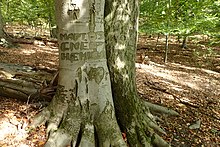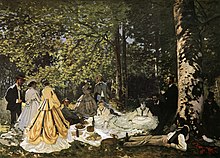tree with initals engraving drawing

Tree carving in Bielinek (Bellinchen), Pomerania, immediately east of the Oder. It reads, in Russian, "March 1945, Death to the Germans."
Arborglyphs, dendroglyphs, silvaglyphs, or modified cultural trees are carvings of shapes and symbols into the bark of living trees. Although most often referring to ancient cultural practices, the term also refers to modern tree-carving.[1]
Love carvings [edit]

Initials of several couples carved into a tree. Most bear dates from the 1920s and 1930s.

Lovers' initials carved into trees.
Carving names and initials into trees is a common practice among lovers; the carvings can last for decades, as a symbol of the permanence of the couple's love. This practice would appear to date back up to the classical era, with Callimachus writing in his Aetia, "But graven on your bark may ye bear such writing as shall declare 'Cydippe beautiful'" (fragment 73). It also appears in the Eclogues of Virgil: "Resolved am I in the woods, rather, with wild beasts to couch, and bear my doom, and character my love upon the tender tree-trunks: they will grow, and you, my love, grow with them."[2]
This carving was also practised in Renaissance England, as evidenced by the writings of William Shakespeare (in As You Like It, 1599) and John Evelyn (in Sylva, 1664).[3]

Le Déjeuner sur l'herbe - Monet (Pushkin Museum)
United States [edit]
Chumash Arborglyph [edit]
The glyph on the "scorpion tree" (now known as the Chumash Arborglyph[4]) viewed from Painted Rock in Carrizo Plain, California, shows the counterclockwise rotation of stars around Polaris, apparently showing Ursa Major in relation to Polaris.[5]
Paleontologist Rex Saint Onge, who saw the tree in 2006, realised that the tree was carved by Native Americans, specifically Chumash people. The ancient oak in the Santa Lucia Mountains in San Luis Obispo County had the outline of a lizard-like being with six legs, nearly 3 ft (0.91 m) tall, carved into its trunk, and included a rectangular crown and two large circles. The Chumash had painted similar designs on rock formations in California.[5]
Saint Onge waa not the first European American to speculate that Chumash paintings might have astronomical implications. In the 1970s, anthropologist Travis Hudson's book Crystals in the Sky combined his observations of rock art with cultural data recorded by ethnographer John P. Harrington nearly a century earlier.[5]
The lower half of the lizard-like image is actually a graphic representation of the movement of a shadow over the course of a year. This was made with a Chumash invention similar to a sundial, in which the stick is aligned with the North Star, and the lines drawn on the rock are traced from the movement of the stick's shadow on the days of the two solstices and equinoxes, which held cultural significance for the Chumash.[4]
Aspen carvings [edit]

Portrait in aspen tree of Tom Mix, dated 1936, Santa Fe National Forest, Río Arriba County, New Mexico

"Haisy 92" carved on a tree; it can be seen how the characters have been stretched as the tree has grown.
Aspen carvings are arborglyphs made in the bark of aspen trees by shepherds, many of them Basque and Irish American, throughout the Western United States. They have been documented across northern California and in areas such as Boise, Idaho and Steamboat Springs, Colorado.[6] A grove of aspens with Basque arborglyphs in the Steens Mountain region of southeastern Oregon have been designated as Oregon Heritage Trees. [7]
A project was run by the USDA Forest Service in 1997 to record and study arborglyphs in the Fremont National Forest of Oregon.[8]
Researchers in Boise, Idaho have also reportedly documented arborglyphs in their area.[9]
In the West the preferred carving tree is the aspen, which has a lifespan of only about 85 years on average.[ citation needed ]
New Zealand [edit]
Chatham Islands [edit]

An example of Chatham Islands carvings
In the Chatham Islands (Rēkohu) of New Zealand, the indigenous Moriori people practised the art of momori rakau, or tree carving.
The carvings depict Moriori karapuna (ancestors) and symbols of the natural world, such as patiki (flounder) and the hopo (albatross). During the late 1998 review 82 trees were found with carvings.[10] Numbers of momori rakau have been steadily declining due to the age of the host trees, stock grazing, wind and in earlier years, people removing the carvings as souvenirs.
The best known examples of momori rakau are at JM Barker (Hapupu) National Historic Reserve, where the carvings and trees are protected by a fenced enclosure and the protection of being one of only two National Historic Reserves in New Zealand. The reserve was fenced in 1980 to provide protection for the tree carvings from grazing stock and is now showing good recovery. Planning is underway between the Department of Conservation (DOC) and the Moriori people to secure a small portion of the reserve for contemporary Moriori carvers to begin a new generation of momori-rakau.[ when? ] [ citation needed ]
The dendroglyph ritual may be associated with death or remembrance. Many scholars over the years have tried to penetrate the reasons behind these incisions into the trunks of the kopi (karaka) trees and have not come up with explanations that satisfy everybody. The dendroglyphs cover a range of features, with many representing human figures and others clearly representative of birds, fish, plants and animals. The momori rakau are among the few visible remaining signs of Moriori culture from pre-European contact.[11]
Damage to trees [edit]

Carving in the bark may damage the tree, by allowing diseases or pests to enter the tree.[1]
References [edit]
- ^ a b Messenger, Steven (11 October 2018). "Archeologists Study the World's Oldest Tree Carvings". Treehugger.
- ^ "They are names of lovers". en.antiquitatem.com. 10 December 2014.
- ^ Porteous, Alexander (3 April 2012). The Forest in Folklore and Mythology. Courier Corporation. ISBN9780486120324 – via Google Books.
- ^ a b "How a tree carving changed the way we understand Chumash rock paintings". Chumash Science Through Time. 6 September 2018. Retrieved 12 October 2022.
- ^ a b c Kettmann, Matt (9 February 2010). "Breaking News, Analysis, Politics, Blogs, News Photos, Video, Tech Reviews". TIME.com . Retrieved 12 October 2022.
- ^ Kelly Bastone, "Aspen Diaries" Archived February 15, 2011, at the Wayback Machine, "Steamboat Magazine", Summer 2005
- ^ "Oregon Travel Experience". Oregon Heritage Trees . Retrieved 20 May 2017.
- ^ here
- ^ "Yahoo News - Latest News & Headlines". news.yahoo.com.
- ^ "Hapupu dendroglyphs". Wondermondo. 6 January 2011.
- ^ "Moriori a people re-discovered, for teachers and students". Archived from the original on 17 September 2008. Retrieved 4 May 2019.
- J. Mallea-Olaetxe, Speaking Through the Aspens: Basque Tree Carvings in California and Nevada, Reno: University of Nevada Press, 2000.
- James B. Dekorne, Aspen Art in the New Mexico Highlands, Santa Fe: Museum of New Mexico Press, 1970.
External links [edit]
Source: https://en.wikipedia.org/wiki/Arborglyph
0 Response to "tree with initals engraving drawing"
Post a Comment